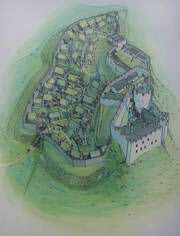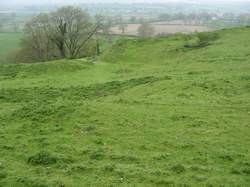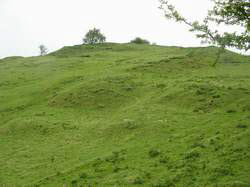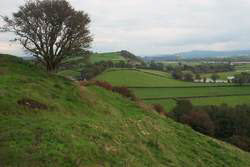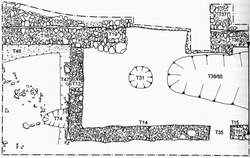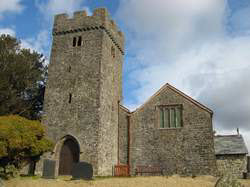Abandoned Communities ..... Tywi Valley
From 1287 both Dinefwr and Dryslwyn were royal castles governed by a constable. The first constable at Dryslwyn was Alan de Plucknet. Accounts for 1287-89 submitted by him to the Exchequer have survived. They give a vivid picture of the reconstruction that was needed after the capture of the castle and of other aspects of life in the castle at that time. Income included:
• Rent of £15 9s from five and a half commotes of land. This was less than had been paid in previous years, presumably reduced to allow for the damage caused by the military action.
• £31 18s 6d for 147 beasts which belonged to Rhys ap Maredudd, and for hay, apples, nuts and ox hides found there.
• Various sums from Italian money lenders, including £300 from Ricardo Giudicionis, merchant of Lucca, received on the feast of St Nicholas.
Expenses included:
• Payments to scouts scouting for Rhys ap Maredudd, 3 janitors and 5 watchmen, of whom 2 janitors got 6d a day and the third 2d, and each watchman 2d a day.
• The wages of Alan de Plucknet at 4s a day, 2 knights at 4s a day, squires and sergeants with barded horses at 12d a day, a squire with an unbarded horse at 6d a day,
• Payments of £129 4s 10d to masons, quarrymen and other petty workmen. Presumably these men were engaged in the rebuilding of the castle.
• Payments of £109 3s 8d to carpenters, smiths and charcoal burners for the building of a new mill.
• Payments of £36 5s 1d to various workers including diggers repairing the fosses round the vill and elsewhere.
• On a livery for two men looking after the stud of my lord the King 23s 3d.
The accounts of Alan de Plucknet and several similar records have been transcribed and translated from Latin by Myvanwy Rhys, Ministers' Accounts for West Wales 1277 to 1306, the Honourable Society of Cymmrodorion, 1936. The original rolls are held in the National Archives.
The expenses listed above include payments for repairing the ditches round the vill. This entry confirms that by 1287 a vill or small town existed close to the castle. It is likely that the town had been established by 1281 as in that year Rhys ap Maredudd received a charter from Edward I granting “one fair at his manor of Dryslwyn for four days duration, to wit on St Bartholomew's Day and the three days following unless the fair be to the damage of neighbouring fairs”. In 1287 a fence was erected around the fair ground and tolls were imposed.
The town of Dryslwyn lay on the hillside north of the castle, the side facing away from the river. On the hillside, which climbed from south west to north east, rough terraces were created to accommodate individual properties known as burgages. Dryslwyn was one of only three Welsh towns known to have been protected by a wall as well as a ditch. The main road into the town came from the north, entering the town close to a large gatehouse. There was a secondary entrance through another gatehouse overlooking the ditch on the south western side. To gain access to the castle it was necessary to pass through the town, cross a bridge, and then go through the main gatehouse.
During the archaeological investigations by Chris Caple and his team just one house in the town was excavated. It lay near the northern corner of the town, abutting the town wall. The house had a clay floor above a clay and stone base. It had stone walls not more than a metre high, which would have supported a timber framework with wattle and daub panels. Its roof was probably made of thatch or wooden shingles. A cluster of nails found in the doorway indicates that once there would have been a wooden door and frame.
During the decade after Dryslwyn castle was captured by the English there were about 37 burgages within the town. Only four of the burgesses were Welsh, and it is assumed that the remainder were English or Flemish immigrants encouraged to settle in order to strengthen the English hold on the area. Records from the early fourteenth century indicate that additional houses were built outside the town wall, probably occupied by Welsh inhabitants of Dryslwyn who had been obliged to move out of the walled area.
The burgesses held agricultural land outside the town. A medieval road ran from Dryslwyn in an easterly direction towards Llangathen, and there is evidence from nineteenth century maps and features of the present landscape that strip fields lay along this road. As well as farming the town's inhabitants would have provided services to the constable and staff at the castle. They carried out building and repairs, they cut the hay in the meadows along the banks of the river, they gathered firewood, they butchered domestic animals, and they transported goods, wine, and honey from Carmarthen.
The town of Dryslwyn does not seem to have had a church. Residents who wished to attend services would have walked two miles or so to St Cathen's church in Llangathen. On the way they would have passed the Iron Age hillfort of Grongaer.
• Rent of £15 9s from five and a half commotes of land. This was less than had been paid in previous years, presumably reduced to allow for the damage caused by the military action.
• £31 18s 6d for 147 beasts which belonged to Rhys ap Maredudd, and for hay, apples, nuts and ox hides found there.
• Various sums from Italian money lenders, including £300 from Ricardo Giudicionis, merchant of Lucca, received on the feast of St Nicholas.
Expenses included:
• Payments to scouts scouting for Rhys ap Maredudd, 3 janitors and 5 watchmen, of whom 2 janitors got 6d a day and the third 2d, and each watchman 2d a day.
• The wages of Alan de Plucknet at 4s a day, 2 knights at 4s a day, squires and sergeants with barded horses at 12d a day, a squire with an unbarded horse at 6d a day,
• Payments of £129 4s 10d to masons, quarrymen and other petty workmen. Presumably these men were engaged in the rebuilding of the castle.
• Payments of £109 3s 8d to carpenters, smiths and charcoal burners for the building of a new mill.
• Payments of £36 5s 1d to various workers including diggers repairing the fosses round the vill and elsewhere.
• On a livery for two men looking after the stud of my lord the King 23s 3d.
The accounts of Alan de Plucknet and several similar records have been transcribed and translated from Latin by Myvanwy Rhys, Ministers' Accounts for West Wales 1277 to 1306, the Honourable Society of Cymmrodorion, 1936. The original rolls are held in the National Archives.
The expenses listed above include payments for repairing the ditches round the vill. This entry confirms that by 1287 a vill or small town existed close to the castle. It is likely that the town had been established by 1281 as in that year Rhys ap Maredudd received a charter from Edward I granting “one fair at his manor of Dryslwyn for four days duration, to wit on St Bartholomew's Day and the three days following unless the fair be to the damage of neighbouring fairs”. In 1287 a fence was erected around the fair ground and tolls were imposed.
The town of Dryslwyn lay on the hillside north of the castle, the side facing away from the river. On the hillside, which climbed from south west to north east, rough terraces were created to accommodate individual properties known as burgages. Dryslwyn was one of only three Welsh towns known to have been protected by a wall as well as a ditch. The main road into the town came from the north, entering the town close to a large gatehouse. There was a secondary entrance through another gatehouse overlooking the ditch on the south western side. To gain access to the castle it was necessary to pass through the town, cross a bridge, and then go through the main gatehouse.
During the archaeological investigations by Chris Caple and his team just one house in the town was excavated. It lay near the northern corner of the town, abutting the town wall. The house had a clay floor above a clay and stone base. It had stone walls not more than a metre high, which would have supported a timber framework with wattle and daub panels. Its roof was probably made of thatch or wooden shingles. A cluster of nails found in the doorway indicates that once there would have been a wooden door and frame.
During the decade after Dryslwyn castle was captured by the English there were about 37 burgages within the town. Only four of the burgesses were Welsh, and it is assumed that the remainder were English or Flemish immigrants encouraged to settle in order to strengthen the English hold on the area. Records from the early fourteenth century indicate that additional houses were built outside the town wall, probably occupied by Welsh inhabitants of Dryslwyn who had been obliged to move out of the walled area.
The burgesses held agricultural land outside the town. A medieval road ran from Dryslwyn in an easterly direction towards Llangathen, and there is evidence from nineteenth century maps and features of the present landscape that strip fields lay along this road. As well as farming the town's inhabitants would have provided services to the constable and staff at the castle. They carried out building and repairs, they cut the hay in the meadows along the banks of the river, they gathered firewood, they butchered domestic animals, and they transported goods, wine, and honey from Carmarthen.
The town of Dryslwyn does not seem to have had a church. Residents who wished to attend services would have walked two miles or so to St Cathen's church in Llangathen. On the way they would have passed the Iron Age hillfort of Grongaer.
Three
Artist’s impression of Dryslwyn castle and the town.
The lower part of Dryslwyn town, showing the entrance through the gatehouse.
The upper part of the town
The main road into the town on the north east side.
Plan of the town house excavated by Chris Caple. T13-
The church at Llangathen. The tower was built in the thirteenth century.
